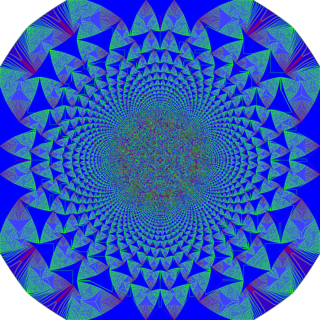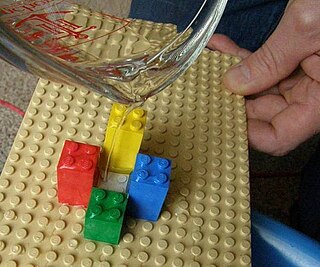 W
WThe Abelian sandpile model, also known as the Bak–Tang–Wiesenfeld model, was the first discovered example of a dynamical system displaying self-organized criticality. It was introduced by Per Bak, Chao Tang and Kurt Wiesenfeld in a 1987 paper.
 W
WCritical opalescence is a phenomenon which arises in the region of a continuous, or second-order, phase transition. Originally reported by Charles Cagniard de la Tour in 1823 in mixtures of alcohol and water, its importance was recognised by Thomas Andrews in 1869 following his experiments on the liquid-gas transition in carbon dioxide, many other examples have been discovered since. The phenomenon is most commonly demonstrated in binary fluid mixtures, such as methanol and cyclohexane. As the critical point is approached, the sizes of the gas and liquid region begin to fluctuate over increasingly large length scales. As the density fluctuations become of a size comparable to the wavelength of light, the light is scattered and causes the normally transparent liquid to appear cloudy. Tellingly, the opalescence does not diminish as one gets closer to the critical point, where the largest fluctuations can reach even centimetre proportions, confirming the physical relevance of smaller fluctuations.
 W
WIn thermodynamics, a critical point is the end point of a phase equilibrium curve. The most prominent example is the liquid–vapor critical point, the end point of the pressure–temperature curve that designates conditions under which a liquid and its vapor can coexist. At higher temperatures, the gas cannot be liquefied by pressure alone. At the critical point, defined by a critical temperature Tc and a critical pressure pc, phase boundaries vanish. Other examples include the liquid–liquid critical points in mixtures.
 W
WIn physics and materials science, the Curie temperature (TC), or Curie point, is the temperature above which certain materials lose their permanent magnetic properties, which can be replaced by induced magnetism. The Curie temperature is named after Pierre Curie, who showed that magnetism was lost at a critical temperature.
 W
WIn chemistry, thermodynamics, and many other related fields, phase transitions are the physical processes of transition between the basic states of matter: solid, liquid, and gas, as well as plasma in rare cases.
 W
WIn physics or mathematics, the scaling limit is a term applied to the behaviour of a lattice model in the limit of the lattice spacing going to zero. A lattice model which approximates a continuum quantum field theory in the limit as the lattice spacing goes to zero corresponds to finding a second order phase transition of the model. This is the scaling limit of the model. It is often useful to use lattice models to approximate real-world processes, such as Brownian motion. Indeed, according to Donsker's theorem, the discrete random walk would, in the scaling limit, approach the true Brownian motion.
 W
WSelf-organized criticality (SOC) is a property of dynamical systems that have a critical point as an attractor. Their macroscopic behavior thus displays the spatial or temporal scale-invariance characteristic of the critical point of a phase transition, but without the need to tune control parameters to a precise value, because the system, effectively, tunes itself as it evolves towards criticality.
 W
WSpinodal decomposition occurs when one thermodynamic phase spontaneously separates into two phases. Decomposition occurs in the absence of nucleation because certain fluctuations in the system reduce the free energy. As a result, the phase change occurs immediately. There is no waiting, as there typically is when there is a nucleation barrier.
 W
WWater retention on mathematical surfaces is the catching of water in ponds on a surface of cells of various heights on a regular array such as a square lattice, where water is rained down on every cell in the system. The boundaries of the system are open and allow water to flow out. Water will be trapped in ponds, and eventually all ponds will fill to their maximum height, with any additional water flowing over spillways and out the boundaries of the system. The problem is to find the amount of water trapped or retained for a given surface. This has been studied extensively for two mathematical surfaces: magic squares and random surfaces. The model can also be applied to the triangular grid.